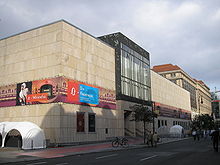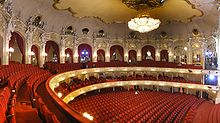- Komische Oper Berlin
-
The Komische Oper Berlin[1] is an opera company in Berlin, Germany, which specializes in German language productions of opera, operetta and musicals.
Since 2004, it has been operated by the Berliner Opernstiftung, and is located on Behrenstraße, just a few steps from the famous Berlin street Unter den Linden.
Contents
History of the Building
The theatre was built between 1891 and 1892 by architects Ferdinand Fellner and Hermann Helmer for a private society. It first opened on September 24, 1892 as "Theater Unter den Linden" with Adolf Ferron's operetta Daphne and Gaul and Haßreiter's ballet Die Welt in Bild und Tanz.
The theatre was primarily a vehicle for operetta, but was also used for various other events and balls. Around 800 people could be seated in the stalls, and the balconies and various en-suite dinner rooms housed about a further 1,700 seats. Its directors went bankrupt in 1896 and the theatre was forced to close its doors.
On September 3, 1898 the theatre was reopened as Metropol-Theater with Julius Freund's revue Paradies der Frauen. It then grew to become one of Berlin's most famous and successful variety theatres. However, due to a decline of variety and music hall entertainment in the late 1920s the theatre was again closed in 1933.
In 1934 the theatre was nationalized and renamed Staatliches Operettentheater. It operated as part of the Nazi Kraft durch Freude entertainment and leisure programmes. During World War II, the auditorium was damaged by Allied bombing on May 7, 1944. The façade, entrance hall, and auditorium ceiling murals were destroyed by bombs on March 9, 1945.
Following repair works and provisional rebuilding, the theatre reopened on December 23, 1947, as the Komische Oper with Johann Strauss's operetta Die Fledermaus.
The 1950s saw various further alterations and extensions. The theatre was completely rebuilt in 1965/1966 by Architektenkollektiv Kunz Nierade, adding functional extensions and giving the theatre a completely new exterior. The theatre reopened again on December 4, 1966, with Mozart's Don Giovanni. The auditorium underwent further restoration in 1986, and the stage technology was further modernized by 1989. Today the theatre seats 1270.
The Komische Oper company
In 1947, Walter Felsenstein founded and led the resident opera company, the Komische Oper, until his death in 1975.[2] Götz Friedrich was an assistant to Felsenstein at the company. Joachim Herz became general director after Felsenstein's death and served until 1981. Subsequently, Harry Kupfer directed the company for 21 seasons, until 2002. The company specializes in German language productions of opera, operetta and musicals. In 2007 the company won, jointly with Oper Bremen, the "Opera house of the year" award by the Geman magazine Opernwelt. Since 2002, the company's chief director and Intendant has been Andreas Homoki. He is scheduled to step down from those posts on 31 July 2012. In June 2008, the company announced the appointment of Barrie Kosky to succeed Homoki as its next Intendant, as of the 2012/2013 season.[3] Since 2005, the company's managing director has been Susanne Moser.
From 1966 to 2004 the theatre was also home to a resident ballet company – first as "Tanztheater der Komischen Oper", and then from 1999 as "BerlinBallett – Komische Oper". In 2004, due to budgetary problems, the separate ballet companies of Berlin's three opera houses were merged into a single company called the Staatsballett Berlin.
Past General Music Directors (GMD) of the company have included Rolf Reuter,[4] Yakov Kreizberg, Kirill Petrenko, and Carl St.Clair. Patrick Lange became GMD of the Komische Oper Berlin as of the 2010/2011 season.[5]
General Music Directors
- Rolf Reuter (1981–1993)
- Yakov Kreizberg (1994–2001)
- Kirill Petrenko (2002–2007)
- Carl St.Clair (2008–2010)
- Patrick Lange (2010–present)
See also
References
- ^ The names mentioned should not be confused with similar names of other theatres in Berlin. The theatre is not identical to the "Theater unter den Linden" which operated from 1933 to 1945 in the former "Kleines Theater" at Unter den Linden 44; nor to the "Staatsoper Unter den Linden", the Berlin State Opera. Neither is it identical to the "Metropol-Theater" that operated in the former Admiralspalast from 1955 into the 1990s. Furthermore, today's "Komische Oper" has no connection to the "Komische Oper (an der Weidendammer Brücke)" which operated from 1905 into the 1920s as an opera theater, later as an operetta theatre, and finally as a revue theatre.
- ^ "East Berlin Opera Nervously Awaits The Next Act". The New York Times. 24 June 1990. http://query.nytimes.com/gst/fullpage.html?res=9C0CE6DE153EF937A15755C0A966958260&pagewanted=all. Retrieved 18 March 2009.
- ^ "Komische Oper Berlin: Barry Kosky neuer Intendant". Focus. 24 June 2008. http://www.focus.de/kultur/musik/komische-oper-berlin-barry-kosky-neuer-intendant_aid_313525.html?drucken=1. Retrieved 21 November 2010.
- ^ "Berliner Dirigent Rolf Reuter gestorben" (in German). Die Welt. 11 September 2007. http://www.welt.de/kultur/article1176319/Berliner_Dirigent_Rolf_Reuter_gestorben.html. Retrieved 20 November 2010.
- ^ Frederik Hanssen (20 May 2010). "Meister von morgen" (in German). Der Tagesspiegel. http://www.tagesspiegel.de/kultur/meister-von-morgen/1841954.html. Retrieved 20 November 2010.
External links
- Komische Oper Berlin website (in German)
- Komische Oper history timeline, English-language version
- Komische Oper on postcards
Coordinates: 52°30′57″N 13°23′13″E / 52.51583°N 13.38694°E
Categories:- German opera companies
- Opera houses in Germany
- Music in Berlin
- Theatres in Berlin
- Buildings and structures completed in 1892
- Organizations established in 1892
- Fellner & Helmer buildings
Wikimedia Foundation. 2010.



